The way teams evolve their tactics to utilise playing with two holding midfielders, or a “double pivot”, is a tactic that undergoes constant tweaks at the elite level.
Historically, one midfielder would simply occupy one half of the pitch and the other the opposite half.
In this year’s European Championship, interesting tactical variations have increased the dynamism of these two players.
Switzerland, who will be used in this tactical analysis, have been particularly creative and successful with their use of a double pivot.
This tactical theory will analyse how Switzerland’s double-pivot receives the ball from their backline and either progresses the ball up the pitch or switches the point of attack. Both the movement and synchronisation of the two players will be analysed, as well as the individual movements and body orientation of each player.
This analysis will also show how the midfielders create space for others without necessarily touching the ball.
This tactical analysis will offer example training exercises that coaches can implement based on the movements and combinations of elite midfielders.
Showing short to play long
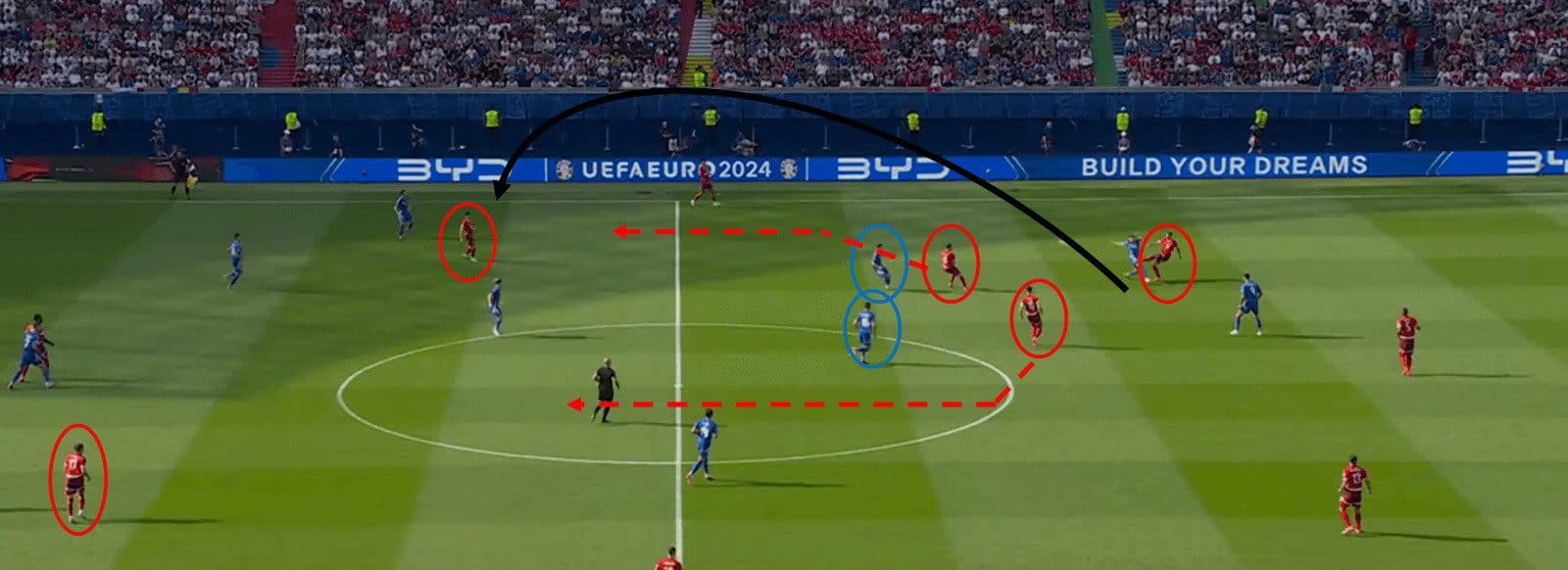
In the opening stages of the game against the current European champions, Switzerland used their midfield movement to play long, directly into their forwards.
To accommodate this, both central midfielders, former Arsenal captain Granit Xhaka and Serie A’s Remo Freuler, simultaneously dropped towards the ball carrier to receive the ball.
This movement brought the Italy midfield, who were playing in a classic 4-3-3, into a high position creating separation between themselves and their backline.
With Italy’s 6, Nicolo Fagioli of Juventus, remaining central, Switzerland exploited the space either side of him by playing long into inverted wingers.
As the ball was played up to the forward, the midfielders immediately spun into the space they had created to support underneath their receiving teammate and pick up the second ball or lay-off.
Narrow positioning
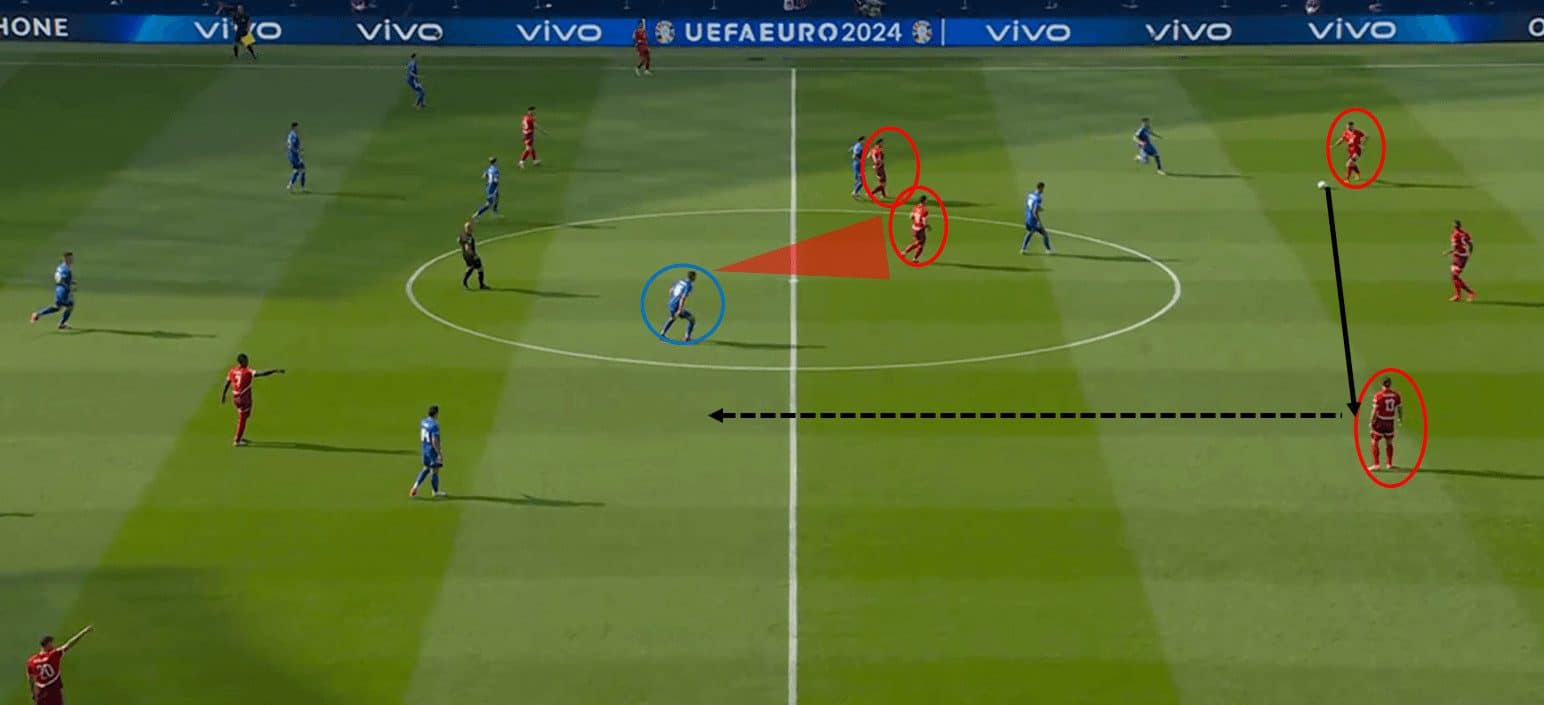
Often, when the centre-backs are in possession, Freuler and his Bundesliga teammate move towards the ball and narrow off very close to each other.
As shown in the above image, this has the effect of also narrowing the opposition midfielders.
This creates a pocket of space between the central midfielder and the ball-far winger.
Switzerland exploited this space in two key ways.
In this example, the inverted left-back was able to receive and break two lines of pressure by attacking the space with the ball at his feet.
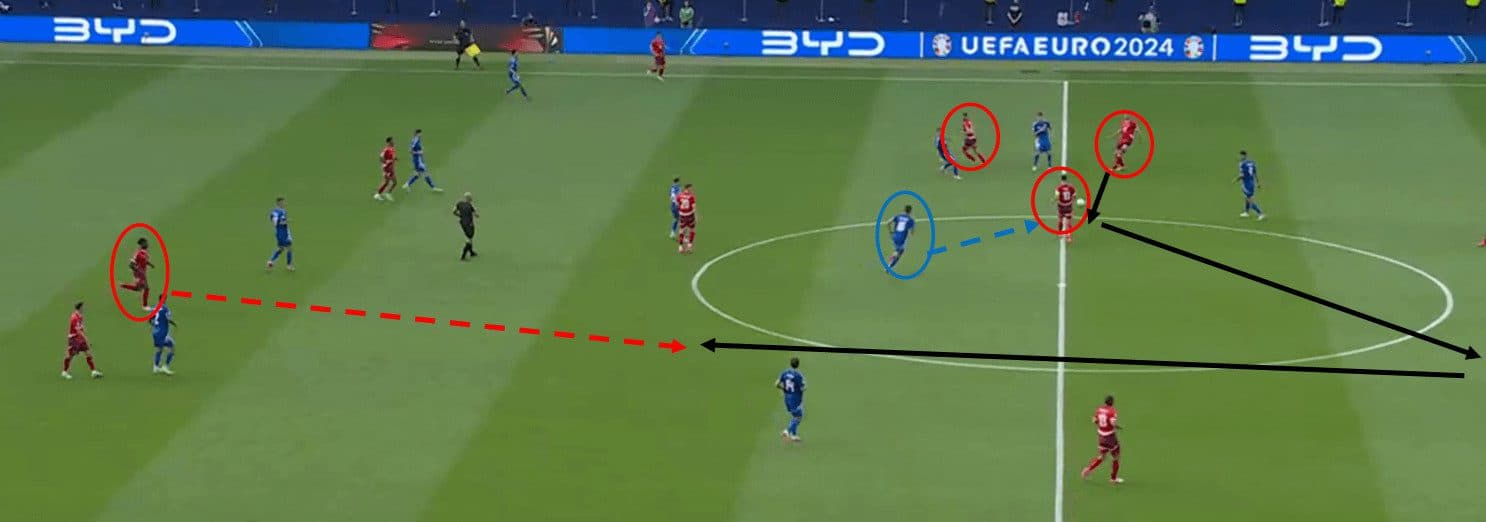
On other occasions, the same midfielder movements created space for either an inverted winger or the striker to drop into the half-space and receive.
The image above shows the build-up to Switzerland’s first goal against the raining European Champions.
By Xhaka receiving a short pass from his centre-back with a closed-off body shape, he drew in Italy’s right-sided central midfielder.
When the Europa League finalist then switched the play to his ball-far centre-back (just out of shot), the centre-back had a clear passing lane into his striker, Breel Embolo.
With both wingers inverted and occupying the two defenders closest to Embolo’s marker, the centre-back responsible for the striker hesitated to track his man.
This allowed Embolo the opportunity to receive, turn and find his winger.
Bounce pass
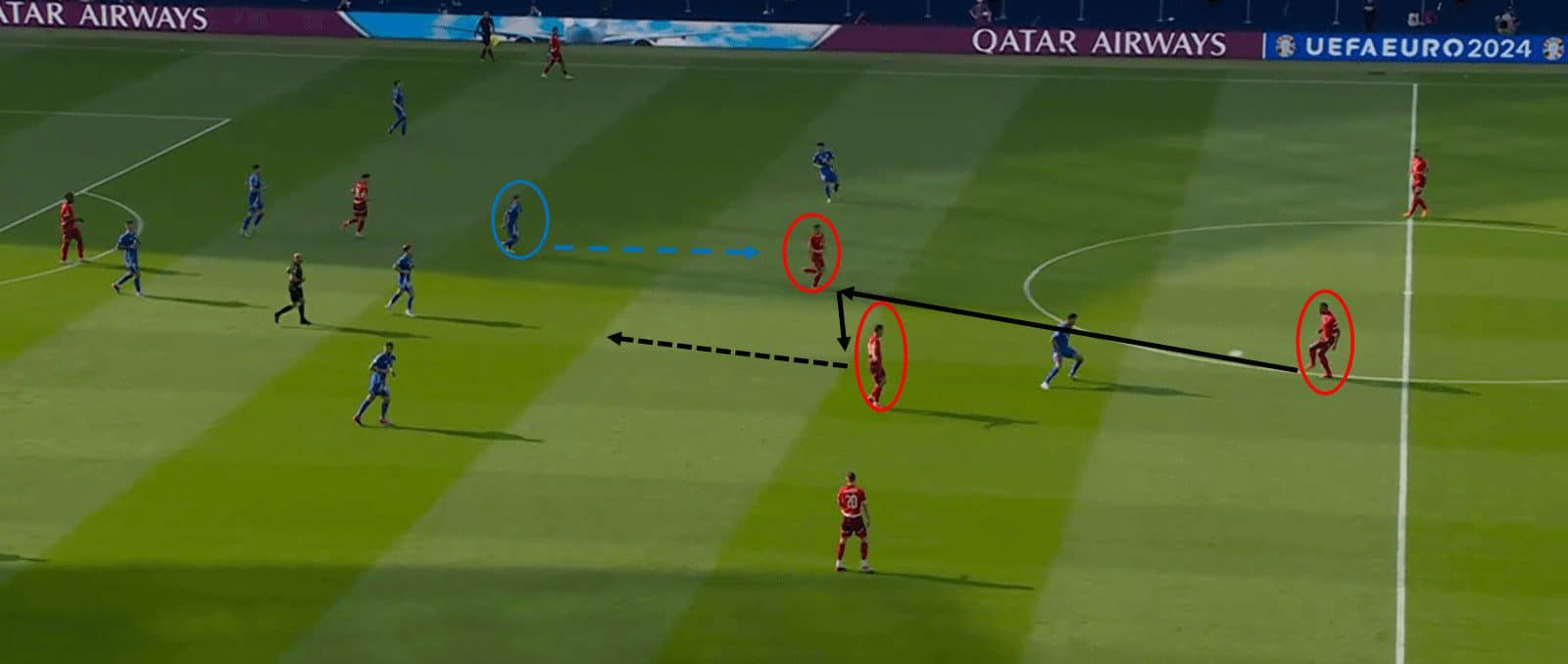
Another trait of Switzerland’s midfield pairing is to combine with bounce passes to either switch the play or progress the ball forward.
As the above image shows, the deeper of the two midfielders shows on one side of the pressing striker to draw his attention.
Then, coming from a more advanced position, the second midfielder shows on the opposite side to receive and play a bounce pass to his teammate and away from the oncoming pressure.
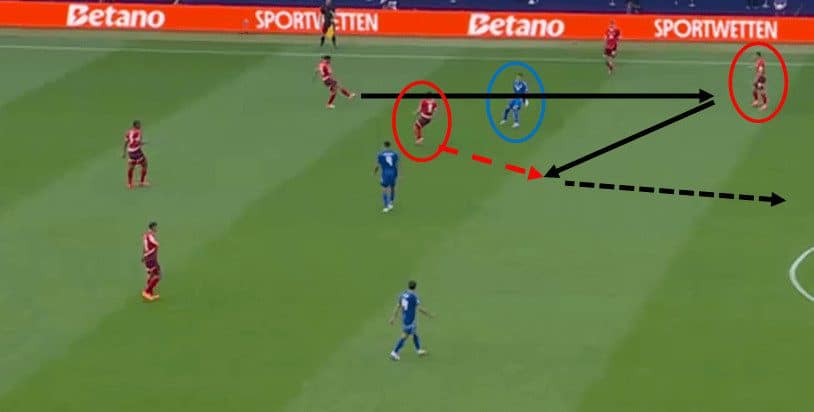
The deeper midfielder’s positioning, underneath his teammate and body-orientated, allows him to receive facing forward and either drive out with the ball or play a forward pass.
This is a very fast and efficient way of progressing the ball forward, as it is completed without a player having to risk turning into pressure.
Because the players are facing one another, it also allows for fast, one-touch passes.
Y-passing sequence
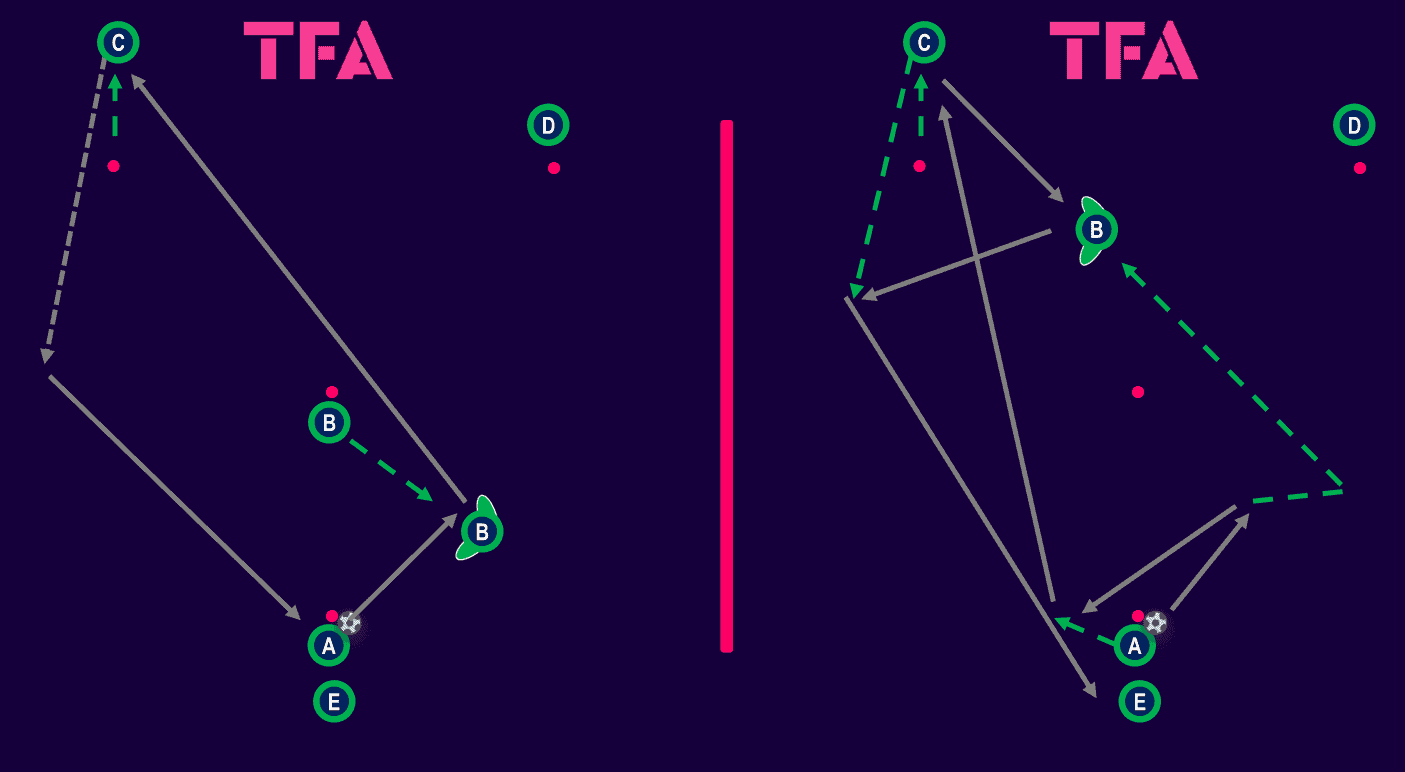
The following coaching exercises are designed to work on the individual movements, body orientations and combinations between the two defensive midfielders.
The exercises can be used to develop midfielders’ ability to progress and/or switch the ball during the build-up phase.
This classic Y-passing pattern works on the timing of midfielder’s movements and their body orientation to receive from their centre-backs.
This exercise can be incorporated as part of the warmup and has many possible variations.
In the first example, shown on the left, the midfielder moves from a central position to create an angle to receive from their centre-back.
The midfielder should receive on their back foot and take a forward touch to allow their next action to be a pass into the player representing their forward.
The forward’s trigger to move is the midfielder’s first touch.
The forward should keep backtracking until the ball is played so as to receive the ball on the move.
The midfielder should be encouraged to mimic a pushing-off motion to help create separation between themselves and the nearest defending player.
Setting up the exercise with two players on the central cone can add an element of realism.
The second option uses the same initial midfielder movement but with a bounce pass back to the centre-back.
This is to simulate a situation where the defending midfielder has got tight enough to prevent the ball going forward straight away.
The centre-back plays into the forward through the passing lane, which has been opened.
The forward bounces the ball back, playing a one-two with the midfielder who has supported the play.
As with the first variation, the timing of movements is vital. The midfielder should be encouraged to burst into the space to receive from the forward at the last possible moment.
Double-pivot passing sequence
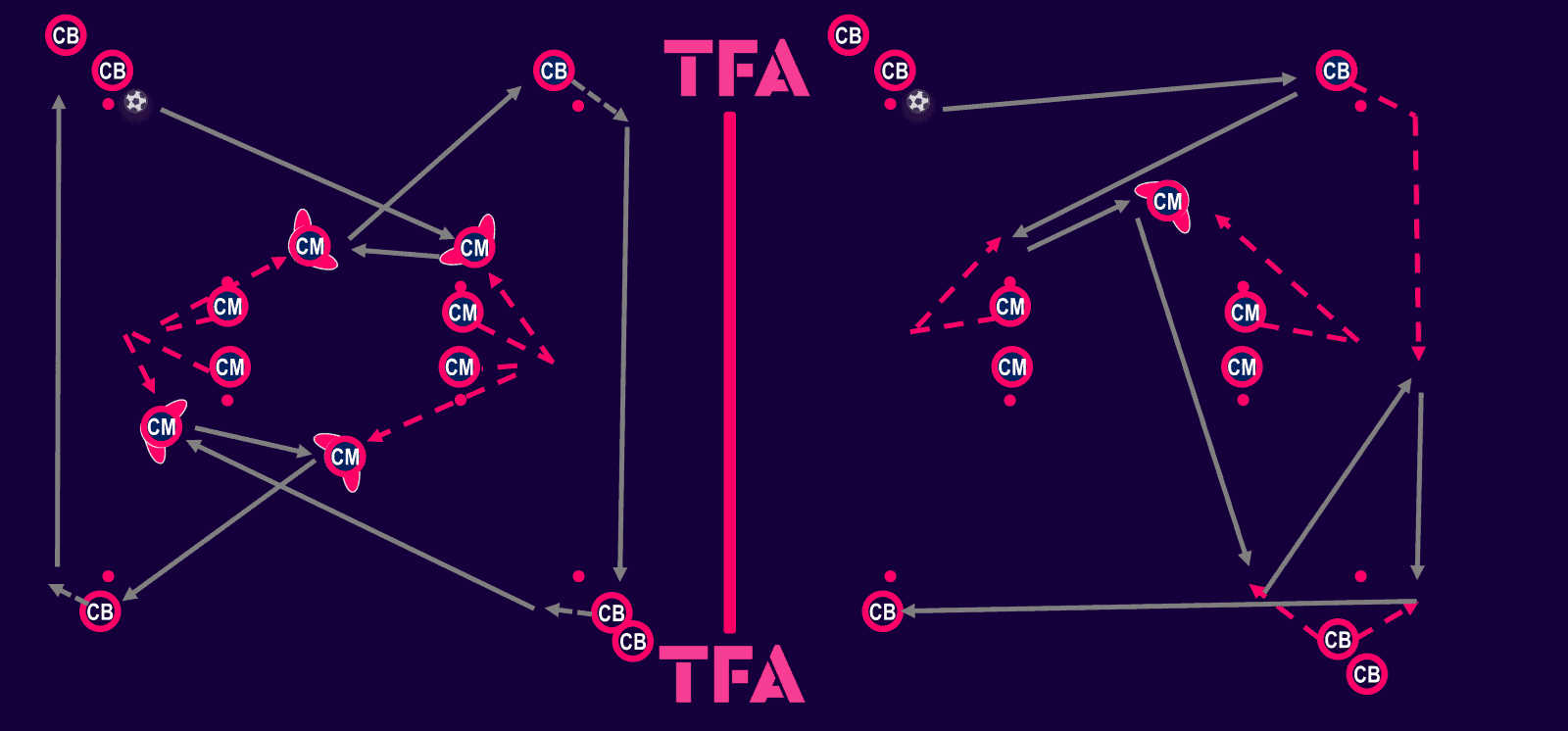
This exercise is designed specifically for midfielders operating in a double pivot.
It is set up to allow them to combine to switch the point of attack or to play into their forwards.
The first rotation sees the ball being played into the ball-far midfielder, who has backtracked away, at an outward angle, from their marker before bursting in front to receive.
The opposite midfielder simultaneously makes the same movement to outside of their marker before arriving on the end of a lay off to switch the play.
The centre-back then drives forward with the ball, simulating attacking the space that has been created.
The initial movements of the midfielders to open up to the outside of the opposition’s shape is designed to achieve one of two things.
Either the opposition remains narrow and allows the ball to be received on their outside, or they open up, allowing a passing lane into the forwards.
Coaches should emphasise the importance of the timing of player movements.
The midfielders, in particular, should be encouraged to arrive at the ball at the last possible second.
This, along with double movements and appropriate body orientation, makes it near impossible for the opposition to mark them or read the play.
Speed of play and firm, clean, line-breaking passes should also be highlighted.
When laying the ball off, the weight should be taken out of the pass to allow next, firm, pass to easily be played.
This sequence can be adapted with the exercise progressing to work on a second way of the midfielders combining.
This involves a bounce pass and a “round the corner” ball into the striker.
The sequence begins with a sideways pass between players representing centre-backs.
Just as in the Switzerland example, the ball far “central-midfielder” moves off the nearest defender to receive, facing his midfield teammate, who is now supporting underneath.
The ball bounces between midfielders and is then drilled into the striker.
The striker plays a one-two before switching and restarting the sequence.
Two vs two plus four rondo
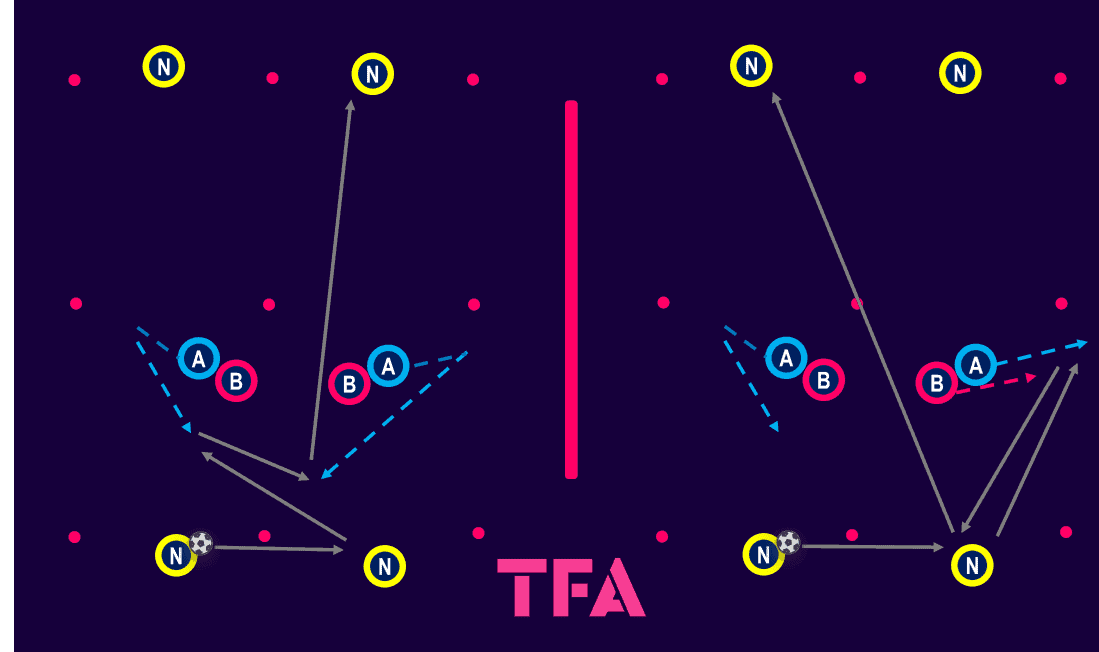
This two vs two plus four rondo puts players into a live, game-like scenario.
The working players are split into two teams of two with two neutral players on each end.
The purpose of the exercise is for the two in-possession players to receive the ball in one box before switching the ball to the opposite box and transitioning to that side to repeat.
To develop their combination play, the midfielders must receive from the neutral players and pass to each other before switching the ball and supporting their pass. The rondo can then be progressed (shown on right) to allow the neutral players to find the other side.
This allows the in-possession midfielders to develop their runs to move the opposition and create space for teammates.
This helps develop all the players’ decision-making about when to attempt a forward, line-breaking pass.
Conclusion
The double pivot is an ever-evolving position, with coaches implementing various movements and rotations to create space and progress the ball.
As seen with Switzerland, even when missed out, the movement of these players can be pivotal in progressing the ball and creating goalscoring opportunities.
Coaches can improve their midfield players by developing effective movements, optimal body orientation, and decision-making regarding when to play forward.






Comments